
Concept explainers
(a)
Interpretation: The name of the following compound needs to be determined.

Concept Introduction : The name of an organic compound has three parts, prefix, parent chain and suffix. The format of naming is prefix+parent chain+suffix. The parent chain is the longest chain of carbon atoms in the compound. Suffix denote the name of
(a)
Answer to Problem 13E
The name of the compound is but-1-ene.
Explanation of Solution
The structure of the compound is,

The parent chain consists of four carbon atoms. So, the name of parent chain is ‘but’. The compound contains one double bond so, suffix is ‘ene’. So, the name of the compound is but-1-ene.
(b)
Interpretation: The name of the following compound needs to be determined.

Concept Introduction : The name of an organic compound has three parts, prefix, parent chain and suffix. The format of naming is prefix+parent chain+suffix. The parent chain is the longest chain of carbon atoms in the compound. Suffix denote the name of functional group and prefix denote the substituent present in the compound.
(b)
Answer to Problem 13E
The name of the compound is 2-methylbut-2-ene.
Explanation of Solution
The compound is as follows:

In the above compound, four carbon atoms present in the parent chain. So, the name of the parent chain is ‘but’. The compound consists of double bond so, the suffix is ‘ene’. There is one methyl substituent present at C2 so, the name of the compound is 2-methylbut-2-ene.
(c)
Interpretation: The name of the following compound needs to be determined.

Concept Introduction : The name of an organic compound has three parts, prefix, parent chain and suffix. The format of naming is prefix+parent chain+suffix. The parent chain is the longest chain of carbon atoms in the compound. Suffix denote the name of functional group and prefix denote the substituent present in the compound.
(c)
Answer to Problem 13E
The name of the compound is 2, 5-dimethylhept-3-ene.
Explanation of Solution
The compound is as follows:

In the above compound, parent chain consists of seven carbon atoms. So, the name of parent chain is ‘hept’ and there is one double bond at C3 so, suffix is ‘ene’. There are two methyl groups present at C2 and C5 so, the name of the compound is 2,5-dimethylhept-3-ene.
(d)
Interpretation: The name of the following compound needs to be determined.

Concept Introduction: The name of an organic compound has three parts, prefix, parent chain and suffix. The format of naming is prefix+parent chain+suffix. The parent chain is the longest chain of carbon atoms in the compound. Suffix denote the name of functional group and prefix denote the substituent present in the compound.
(d)
Answer to Problem 13E
The name of the compound is 2,3-dimethylpent-1-ene.
Explanation of Solution
The compound is as follows:

In the compound, five carbon atoms present in the parent chain. So, the name of parent chain is ‘pent’ and one double bond present in C1 so, suffix ‘ene’ should be used. Two methyl groups present as substituent in C2 and C3. So, the name of the compound is 2,3-dimethylpent-1-ene.
(e)
Interpretation: The name of the following compound needs to be determined.
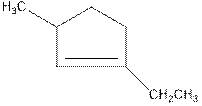
Concept Introduction: In naming of cyclic compound, naming is done in the format,
Prefix+Cyclo+parent chain+suffix
Prefix denotes the name of the substituent. If more than one substituent are present, they should be arranged in alphabetical order.
(e)
Answer to Problem 13E
The name of the compound is 1-ethyl-3-methylcyclopent-1-ene.
Explanation of Solution
The compound is as follows:
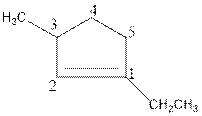
Above compound is a cyclic compound. The cyclic ring consists of five carbon atoms. So, the name of parent chain is ‘cyclopent’. One double bond is present in C1 so, suffix ‘ene’ should be used. One ethyl substituent is present in C1 and one methyl substituent is present in C3. So, the name of the compound is 1-ethyl-3-methylcyclopent-1-ene.
(f)
Interpretation: The name of the following compound needs to be determined.
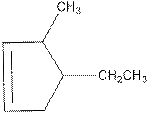
Concept Introduction: In naming of cyclic compound, naming is done in the format,
Prefix+Cyclo+parent chain+suffix
Prefix denotes the name of the substituent. If more than one substituent are present, they should be arranged in alphabetical order.
(f)
Answer to Problem 13E
The name of the compound is 4-ethyl-3-methylcyclopent-1-ene.
Explanation of Solution
The compound is as follows:
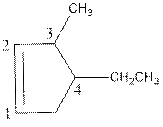
Above compound is a cyclic compound. The cyclic ring consists of five carbon atoms. So, the name of parent chain is ‘cyclopent’. One double bond is present in C1and C2 so, suffix ‘ene’ should be used. One ethyl substituent is present in C4 and one methyl substituent is present in C3. So, the name of the compound is 4-ethyl-3-methylcyclopent-1-ene.
(g)
Interpretation: The name of the following compound needs to be determined.

Concept Introduction: The name of an organic compound has three parts, prefix, parent chain and suffix. The format of naming is prefix+parent chain+suffix. The parent chain is the longest chain of carbon atoms in the compound. Suffix denotes the name of functional group and prefix denote the substituent present in the compound.
(g)
Answer to Problem 13E
The name of the compound is 4-methylpent-2-yne.
Explanation of Solution
The compound is as follows:
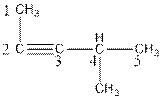
The parent chain of the compound consist of five carbon atoms, so, the name of parent chain is ‘pent’ and one triple bond is present in C2-C3, so, the suffix will be ‘yne’. One methyl substituent is present in C4. So, the name of the compound is 4-methylpent-2-yne.
Want to see more full solutions like this?
Chapter 21 Solutions
EBK CHEMICAL PRINCIPLES
- Label each of the seven designated regions of the following multi-component, solid-liquid phase diagram for the Zinc - Magnesium system.arrow_forward22arrow_forwardPLEASE READ!!! I DONT WANT EXAMPLES, I DONT WANT WORDS OR PARAGRAPHS FOR THE MECHANISM!!! THANKS First image: QUESTION 6. I have to show, with ARROWS and STRUCTURES, the mechanism of the reaction at the bottom. Also I have to show by mecanism why the reaction wouldn't work if the alcohol was primary. I also tried to draw the mechanism, tell me what to change. Please note that its an AMIDE thats formed not an AMINE the nitrogen has ONE hydrogen and one Phenyl-C-Phenyl. I already asked for this mechanism and got as a final product ...-NH2 not whats shown on the picture, thank you Ths second part. QUESTION 3. I just need a way to synthesize the lactone A, I already started please continue from where I left it Second image: I simply need the products, substrates or reagents, thank youarrow_forward
- Indicate how to prepare a 10% sodium hydroxide (NaOH) solution to a slightly alkaline pH.arrow_forwardCH, CH CH₂ CH₂ Phytyl side chain 5. What is the expected order of elution of compounds A-D below from a chromatography column packed with silica gel, eluting with hexane/ethyl acetate? C D OHarrow_forwardPlease analze my gel electrophoresis column of the VRK1 kinase (MW: 39.71 kDa). Attached is the following image for the order of column wells and my gel.arrow_forward
- 2.0arrow_forwardWrite the electron configuration of an atom of the element highlighted in this outline of the Periodic Table: 1 23 4 5 6 7 He Ne Ar Kr Xe Rn Hint: you do not need to know the name or symbol of the highlighted element! ☐arrow_forwardCompare these chromatograms of three anti-psychotic drugs done by HPLC and SFC. Why is there the difference in separation time for SFC versus HPLC? Hint, use the Van Deemter plot as a guide in answering this question. Why, fundamentally, would you expect a faster separation for SFC than HPLC, in general?arrow_forward
- A certain inorganic cation has an electrophoretic mobility of 5.27 x 10-4 cm2s-1V-1. The same ion has a diffusion coefficient of 9.5 x 10-6cm2s-1. If this ion is separated from cations by CZE with a 75cm capillary, what is the expected plate count, N, at an applied voltage of 15.0kV? Under these separation conditions, the electroosmotic flow rate was 0.85mm s-1 toward the cathode. If the detector was 50.0cm from the injection end of the capillary, how long would it take in minutes for the analyte cation to reach the detector after the field was applied?arrow_forward2.arrow_forwardPlease solve for the following Electrochemistry that occursarrow_forward
 Chemistry for Today: General, Organic, and Bioche...ChemistryISBN:9781305960060Author:Spencer L. Seager, Michael R. Slabaugh, Maren S. HansenPublisher:Cengage Learning
Chemistry for Today: General, Organic, and Bioche...ChemistryISBN:9781305960060Author:Spencer L. Seager, Michael R. Slabaugh, Maren S. HansenPublisher:Cengage Learning Introductory Chemistry: A FoundationChemistryISBN:9781337399425Author:Steven S. Zumdahl, Donald J. DeCostePublisher:Cengage Learning
Introductory Chemistry: A FoundationChemistryISBN:9781337399425Author:Steven S. Zumdahl, Donald J. DeCostePublisher:Cengage Learning- Chemistry: Matter and ChangeChemistryISBN:9780078746376Author:Dinah Zike, Laurel Dingrando, Nicholas Hainen, Cheryl WistromPublisher:Glencoe/McGraw-Hill School Pub Co
 ChemistryChemistryISBN:9781305957404Author:Steven S. Zumdahl, Susan A. Zumdahl, Donald J. DeCostePublisher:Cengage Learning
ChemistryChemistryISBN:9781305957404Author:Steven S. Zumdahl, Susan A. Zumdahl, Donald J. DeCostePublisher:Cengage Learning Chemistry: An Atoms First ApproachChemistryISBN:9781305079243Author:Steven S. Zumdahl, Susan A. ZumdahlPublisher:Cengage Learning
Chemistry: An Atoms First ApproachChemistryISBN:9781305079243Author:Steven S. Zumdahl, Susan A. ZumdahlPublisher:Cengage Learning





